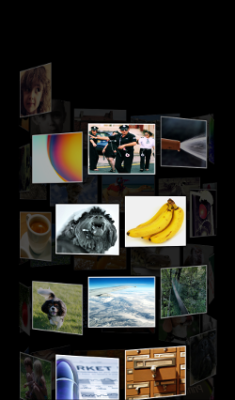ItemView: Item Container with Layouts
The Dali::Toolkit::ItemView class is a scrollable container that can contain many items. It provides several scrollable layouts, as illustrated in the following figure.
Figure: ItemView layouts
| Grid | Spiral | Depth |
 |
 |
 |
You can also create your own custom layout by inheriting from the Dali::Toolkit::ItemLayout class.
Implementing ItemFactory
To create a Dali::Toolkit::ItemView instance, you must create your own ItemFactory class by deriving from the Dali::Toolkit::ItemFactory class and providing its instance to the ItemView::New() function. ItemFactory is an abstract class having 2 pure virtual member functions to create items and get the number of created items. The following basic example shows how to implement an ItemFactory class:
class MyFactory : public ItemFactory
{
public:
virtual unsigned int GetNumberOfItems()
{
// Return the number of items
return MY_ITEM_COUNT;
}
virtual Actor NewItem( unsigned int itemId )
{
// Create the actor representing the item based on the itemId
return ImageView::New( MY_IMAGE_PATHS[itemId] );
}
};
The overridden functions in the derived class are called by the ItemView object.
Creating an ItemView
The following basic example shows how to create a Dali::Toolkit::ItemView object:
// This sample code is for the HelloWorldExample class // in Creating a DALi Application class HelloWorldExample : public ConnectionTracker { // Store a factory as a member variable MyFactory mFactory; }; void HelloWorldExample::Create( Application& application ) { // Create an ItemView with the factory ItemView itemView = ItemView::New( mFactory ); itemView.SetParentOrigin( ParentOrigin::CENTER ); // Create a layout ItemLayoutPtr spiralLayout = DefaultItemLayout::New( DefaultItemLayout::SPIRAL ); // Add the layout to the itemView itemView.AddLayout( *spiralLayout ); // More layouts can be created and added to the itemView // Activate the layout itemView.ActivateLayout( 0, Vector3( Stage::GetCurrent().GetSize() ), 0 ); // Add the itemView to the stage Stage::GetCurrent().Add( itemView ); }


